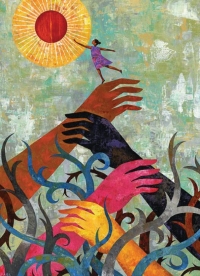With 2020 behind us, this commemorative calendar no longer functions as a calendar, but remains a powerful inspirational and educational tribute to the Women's Suffrage Centennial.
Please note that the calendar grid uses a different format from what we've done in the past. Each week starts with Monday, rather than Sunday. We thought this would be a useful change for the majority of us who experience our week as beginning on Monday. It's been a difficult adjustment for many buyers. Apologies for the difficulty.
Hear Us Roar 2020 features original artwork, archival photos and graphics, Hear Us Roar! celebrates and honors the 72 year-long movement that women waged to win the vote. The calendar amplifies the ignored or suppressed voices of women of color and working class women. It acknowledges that the struggle for true equality and liberation is ongoing. 12x12”, hundreds of suffrage and women's rights historical dates included. This was such an important anniversary that SCW has produced a special commemorative calendar in addition to our annual Peace Calendar.
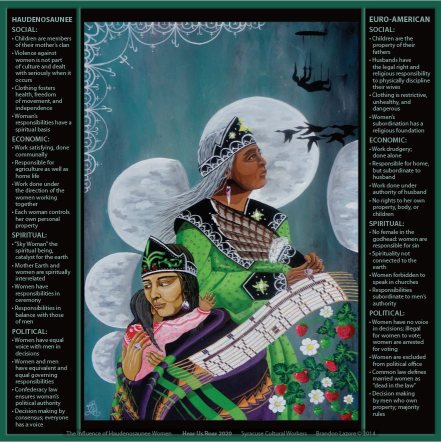
JANUARY
The Influence of Haudenosaunee Women
Art: Women’s Nomination acrylic painting by Brandon Lazore © 2014
Image Text: Reproduced with permission of author from Sisters in Spirit:Haudenosaunee (Iroquois) Influence on Early American Feminists by Sally Roesch Wagner (Native Voices, 2001).
In traditional Haudenosaunee (Iroquois) culture women have important leadership responsibilities. There is balance between women and men. Early US feminists were deeply inspired by the freedom, political power and respect they saw embodied by Haudenosaunee women. Their lives provided a model to early feminists Elizabeth Cady Stanton, Lucretia Mott, Matilda Joslyn Gage and others. This living example reinforced their own understanding that equality was possible and worth the struggle required to achieve it.
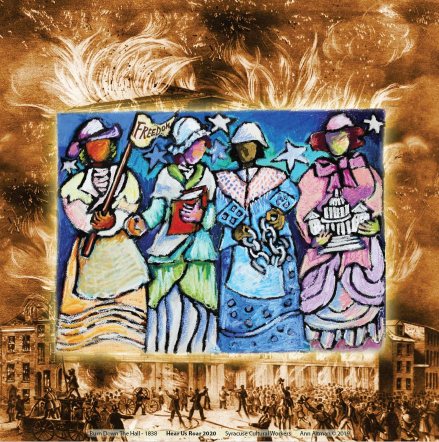
FEBRUARY
Burning Down the Hall – 1838
Art: Suffragists oil pastel / mixed media drawing by Ann Altman © 2019
Background Image: Bowen, J. T. & Wild, J. C. (1838) Destruction by fire of Pennsylvania Hall, the new building of the Abolition Society, on the night of the 17th May. Library of Congress: 2014645336
African American and white women abolitionists working together was so threatening to pro-slavery men that a mob burned down Pennsylvania Hall in Philadelphia where the women met for the second Anti-Slavery Convention of American Women. With the hall surrounded and windows being shattered, the women courageously voted to extend the meeting into the evening. When they finally exited, two abreast through a gauntlet of infuriated men, a white woman joined arms with each African American woman for protection.

MARCH
Women Come Together for Justice 1848-1860
Art: Center - digital graphic by SCW © 2019. Historical images clockwise from top left: Woman Suffrage Convention! ad by NYS Woman’s Suffrage Association, Library of Congress (LoC); Women’s Suffrage March and Mass Meeting poster printed by J. Weiner LTD., London, UK, designed by Watts, C. M. ca. 1907-1918, Harvard Library; Sojourner Truth lecture poster, Bentley Historical Library; poster designed by SCW from article in the Anti-Slavery Bugle, April 13, 1850, LoC; Scrapbooks, On the Woman’s Rights Convention, prepared by Elizabeth Cady Stanton in 1848, LoC; Men! Give women votes to protect the children poster for the International Woman Suffrage Alliance designed by Willy Pogány in 1914, New York Public Library.
Less formally, women had been advocating for their rights for decades before five women met in mid-July 1848, to plan the first Women’s Rights Convention in Seneca Falls, NY. Held July 19-20, it was followed by another in Rochester. Resolutions, including Elizabeth Cady Stanton’s revolutionary Declaration of Sentiments, were signed by 68 women and 32 men. Regional conventions followed and in 1850 in Worcester, MA, a national convention drew 1,000 people from 11 states. A third national was held in 1852 in Syracuse. It was the first convention for future leaders Matilda Joslyn Gage and Susan B. Anthony.

APRIL
Suffragists Support the War Against Slavery – 1862
Art: Matilda Joslyn Gage and the Cause of the War pencil, ink, and digital drawing by Sanya Hyland © 2019
On August 28, 1862, Matilda Joslyn Gage was chosen by the women of Fayetteville, NY (near Syracuse) to present a flag to the local 122nd Union regiment. As they carried the flag off to battle, Matilda reminded them that the Civil War was not being fought to preserve the Union, as President Lincoln claimed, but to end slavery.
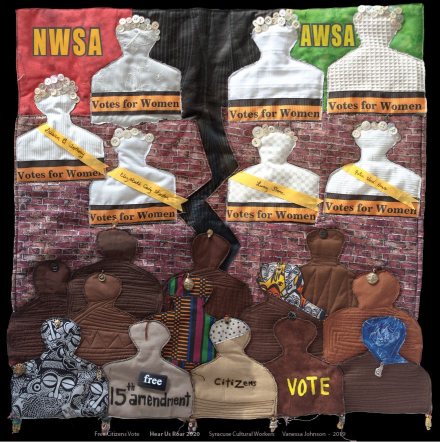
MAY
A Movement Divided
Art: Free Citizens Vote mixed media story quilt by Vanessa Johnson – 2019
In the aftermath of the Civil War, the 13th , 14th and 15th Amendments made slavery illegal, affirmed new rights of freed women and men, granted citizenship to everyone born in the US, (including those formerly enslaved), and guaranteed voting rights to all male citizens 21 and over. It added the first mention of gender in the Constitution, legally excluding women from voting at the federal level and dividing women’s rights activists. The AWSA (American Woman Suffrage Association) supported the Fifteenth Amendment granting voting rights to African American men and focused exclusively on women’s suffrage. The NWSA (National Woman Suffrage Association) advocated for a range of reforms to make women equal members of society.
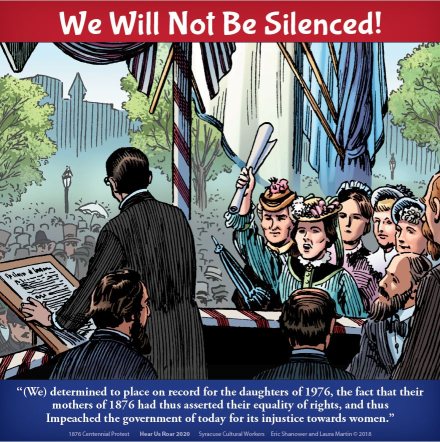
JUNE
1876 Centennial Protest
Art: excerpt from Matilda Who? pen and ink, and digital color comic by Eric Shanower (artist) and Laura Martin (color) © 2018
Women’s rights activists crashed the party at the nation’s Centennial Celebration at Independence Square in Philadelphia. Leading a group of five women, Susan B. Anthony presented a “Declaration of Rights of the Women of the United States” on behalf of the National Woman Suffrage Association. The five then walked to an empty platform nearby where Anthony read the four-page document to a crowd that quickly gathered.

JULY
Statue Unveiled – Hypocrisy Exposed
Art: mixed media illustration by Bec Young © 2019
The NY Woman Suffrage Association organized a protest to highlight the contradiction of a grand celebration for a statue of a woman representing liberty while denying women the right to vote. The organizers described the vote as a means to attain full rights for women – better working conditions for women, children and men, custody rights, rights of sex workers, protection from violence and more. Over 200 people filled the suffrage boat which received significant attention during the festivities.
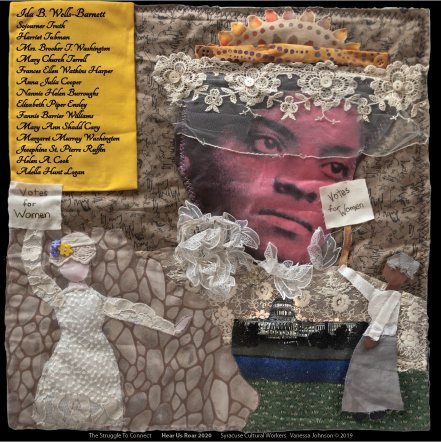
AUGUST
The Struggle to Connect - African American Women Assert Their Role
Art: mixed media fiber quilt by Vanessa Johnson 2019
For decades the Woman Suffrage movement struggled with issues of racism and economic privilege. At the magnificent Woman Suffrage Procession on March 3, 1913 in Washington DC, African American women were told to march in the rear in order to appease segregationists. Longtime activist and journalist Ida B. Wells (and others) resisted this policy. Wells joined in with the Illinois delegation where she was supported by white colleagues. This legacy of racism continues to limit the success of the feminist movement today.

SEPTEMBER
Picketing the White House – 1917
Art: Night of Terror, digital graphic by Meneese Wall © 2017
The National Woman’s Party, led by Alice Paul, began picketing the White House on January 10, 1917, the first such action in US history. With war hysteria rising, mobs attacked the women and on June 22 Woodrow Wilson ordered that picketers be arrested (illegally, of course). But the women persisted and on their banners began using Wilson’s hypocritical rhetoric about democracy against him. In September, imprisoned women demanded political prisoner status. On October 22, Alice Paul, sentenced to seven months, started a hunger strike with Rose Winslow which was met by force-feeding torture. Finally, in late November, the government capitulated and all suffragists were released, many in extremely poor health. Lucy Burns, shown above, did the most prison time of any suffragist.

OCTOBER
Suffrage for Women - 1920
Art: Ratification digital graphic by Meneese Wall © 2018
On May 21, 1919, the House of Representatives finally passed the suffrage amendment. The Senate followed suit. • Next came the arduous task of winning ratification in 36 of 48 states. Urgency seized organizers as they feared the failure of ratification now could mean years of delay. Their task was complicated by having to pressure governors to call special legislative sessions. • The vast network of organizers and activists created by the NWP and NAWSA accomplished the task in 14 months! By early February, 1920, 28 states had ratified. Progress stalled as Governors of CT and VT refused to call special sessions, but Tennessee’s Governor agreed. After a brutal struggle with anti-suffragists, thanks to 24-year-old Harry Burn, Tennessee ratified! The Secretary of State signed the proclamation on August 26 and the 19th Amendment became part of the Constitution. In Alice Paul’s words, “Freedom has come not as a gift but as a triumph!”

NOVEMBER
100 Years of Progress and Disappointment
Art: The Suffrage Quilt with fabric and buttons by Ellen Blalock © 2019
The three women shown in Ellen Blalock’s beautiful quilt, Jeanette, Shirley and Alexandria, represent the 100 years of electoral and racial progress by women in the US. On the quilt, in chronological order, are a number of milestones in the struggle for women’s rights. • The march towards full equality and liberation is filled with successes and setbacks. A major setback has been the failure to ratify the Equal Rights Amendment (ERA) which would provide Constitutionally-protected legal rights to all women. In the words of Alexandria Ocasio-Cortez, “The time to be courageous is NOW!”
Read Full Text
People of Color Targeted Throughout US History
Although the 19th Amendment formally granted voting rights to all women, voting rights remain contested. Women of color and poor women (and men also) have been prevented from voting in a variety of ways. Native American women began receiving voting rights in 1924 (Indian Citizenship Act), though many faced restrictions for many years afterward. Enough barriers continue that The Native American Voting Rights Act of 2019 has been introduced in Congress. The 1943 Repeal of the Chinese Exclusion Act opened the door for very limited Chinese immigration, naturalization and voting rights. The 1952 McCarran-Walter Act granted all people of Asian ancestry the right to become citizens and vote. The 1965 Voting Rights Act sought to finally remove Jim Crow voting restrictions on African Americans. A 1975 extension of the Voting Rights Act enfranchised large numbers of Latinx (and other non-English speakers) by protecting language minorities. Residents of Washington, DC and US territories continue to have limited voting rights. The struggle continues.

DECEMBER
Women Shake Up Congress
Art: collage of photographs from campaign websites and official congressional portraits assembled by SCW Studio ©2019,
Background: watercolor painting by Maxx Hill © 2019.
The 2018 elections produced the most diverse Congress in US history – 42 new women, 24 people of color, the first Indigenous women and first Muslim women, the youngest women and at least ten openly LGBT folks. Many of these new representatives quickly challenged the policies and practices which maintain domination and oppression. With active grassroots movements backing and pushing them, we can achieve greater advances for the liberation of women and all people.


